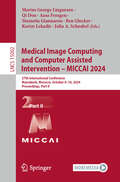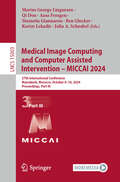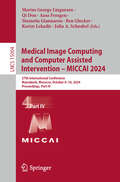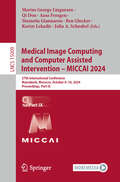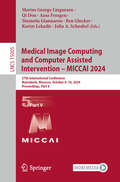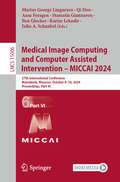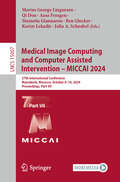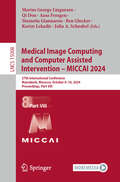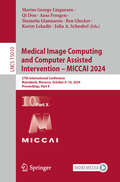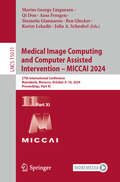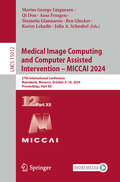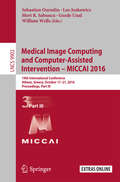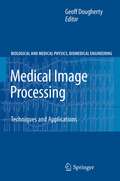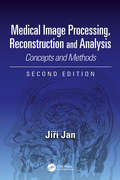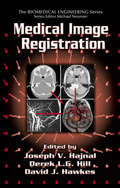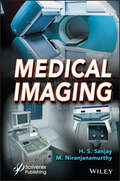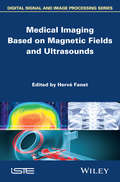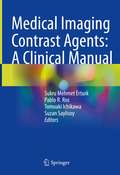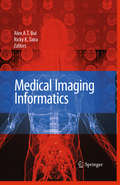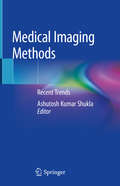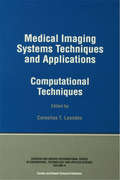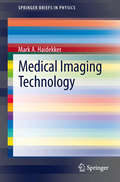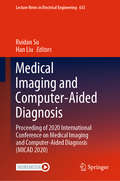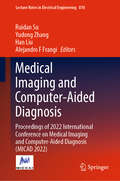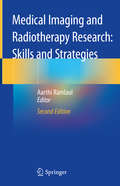- Table View
- List View
Medical Image Computing and Computer Assisted Intervention – MICCAI 2024: 27th International Conference, Marrakesh, Morocco, October 6–10, 2024, Proceedings, Part II (Lecture Notes in Computer Science #15002)
by Marius George Linguraru Aasa Feragen Ben Glocker Julia A. Schnabel Karim Lekadir Qi Dou Stamatia GiannarouThe 12-volume set LNCS 15001 - 15012 constitutes the proceedings of the 27th International Conferenc on Medical Image Computing and Computer Assisted Intervention, MICCAI 2024, which took place in Marrakesh, Morocco, during October 6–10, 2024. MICCAI accepted 857 full papers from 2781 submissions. They focus on neuroimaging; image registration; computational pathology; computer aided diagnosis, treatment response, and outcome prediction; image guided intervention; visualization; surgical planning, and surgical data science; image reconstruction; image segmentation; machine learning; etc.
Medical Image Computing and Computer Assisted Intervention – MICCAI 2024: 27th International Conference, Marrakesh, Morocco, October 6–10, 2024, Proceedings, Part III (Lecture Notes in Computer Science #15003)
by Marius George Linguraru Aasa Feragen Ben Glocker Julia A. Schnabel Karim Lekadir Qi Dou Stamatia GiannarouThe 12-volume set LNCS 15001 - 15012 constitutes the proceedings of the 27th International Conferenc on Medical Image Computing and Computer Assisted Intervention, MICCAI 2024, which took place in Marrakesh, Morocco, during October 6–10, 2024. MICCAI accepted 857 full papers from 2781 submissions. They focus on neuroimaging; image registration; computational pathology; computer aided diagnosis, treatment response, and outcome prediction; image guided intervention; visualization; surgical planning, and surgical data science; image reconstruction; image segmentation; machine learning; etc.
Medical Image Computing and Computer Assisted Intervention – MICCAI 2024: 27th International Conference, Marrakesh, Morocco, October 6–10, 2024, Proceedings, Part IV (Lecture Notes in Computer Science #15004)
by Marius George Linguraru Aasa Feragen Ben Glocker Julia A. Schnabel Karim Lekadir Qi Dou Stamatia GiannarouThe 12-volume set LNCS 15001 - 15012 constitutes the proceedings of the 27th International Conferenc on Medical Image Computing and Computer Assisted Intervention, MICCAI 2024, which took place in Marrakesh, Morocco, during October 6–10, 2024. MICCAI accepted 857 full papers from 2781 submissions. They focus on neuroimaging; image registration; computational pathology; computer aided diagnosis, treatment response, and outcome prediction; image guided intervention; visualization; surgical planning, and surgical data science; image reconstruction; image segmentation; machine learning; etc.
Medical Image Computing and Computer Assisted Intervention – MICCAI 2024: 27th International Conference, Marrakesh, Morocco, October 6–10, 2024, Proceedings, Part IX (Lecture Notes in Computer Science #15009)
by Marius George Linguraru Aasa Feragen Ben Glocker Julia A. Schnabel Karim Lekadir Qi Dou Stamatia GiannarouThe 12-volume set LNCS 15001 - 15012 constitutes the proceedings of the 27th International Conferenc on Medical Image Computing and Computer Assisted Intervention, MICCAI 2024, which took place in Marrakesh, Morocco, during October 6–10, 2024. MICCAI accepted 857 full papers from 2781 submissions. They focus on neuroimaging; image registration; computational pathology; computer aided diagnosis, treatment response, and outcome prediction; image guided intervention; visualization; surgical planning, and surgical data science; image reconstruction; image segmentation; machine learning; etc.
Medical Image Computing and Computer Assisted Intervention – MICCAI 2024: 27th International Conference, Marrakesh, Morocco, October 6–10, 2024, Proceedings, Part V (Lecture Notes in Computer Science #15005)
by Marius George Linguraru Aasa Feragen Ben Glocker Julia A. Schnabel Karim Lekadir Qi Dou Stamatia GiannarouThe 12-volume set LNCS 15001 - 15012 constitutes the proceedings of the 27th International Conferenc on Medical Image Computing and Computer Assisted Intervention, MICCAI 2024, which took place in Marrakesh, Morocco, during October 6–10, 2024. MICCAI accepted 857 full papers from 2781 submissions. They focus on neuroimaging; image registration; computational pathology; computer aided diagnosis, treatment response, and outcome prediction; image guided intervention; visualization; surgical planning, and surgical data science; image reconstruction; image segmentation; machine learning; etc.
Medical Image Computing and Computer Assisted Intervention – MICCAI 2024: 27th International Conference, Marrakesh, Morocco, October 6–10, 2024, Proceedings, Part VI (Lecture Notes in Computer Science #15006)
by Marius George Linguraru Aasa Feragen Ben Glocker Julia A. Schnabel Karim Lekadir Qi Dou Stamatia GiannarouThe 12-volume set LNCS 15001 - 15012 constitutes the proceedings of the 27th International Conferenc on Medical Image Computing and Computer Assisted Intervention, MICCAI 2024, which took place in Marrakesh, Morocco, during October 6–10, 2024. MICCAI accepted 857 full papers from 2781 submissions. They focus on neuroimaging; image registration; computational pathology; computer aided diagnosis, treatment response, and outcome prediction; image guided intervention; visualization; surgical planning, and surgical data science; image reconstruction; image segmentation; machine learning; etc.
Medical Image Computing and Computer Assisted Intervention – MICCAI 2024: 27th International Conference, Marrakesh, Morocco, October 6–10, 2024, Proceedings, Part VII (Lecture Notes in Computer Science #15007)
by Marius George Linguraru Aasa Feragen Ben Glocker Julia A. Schnabel Karim Lekadir Qi Dou Stamatia GiannarouThe 12-volume set LNCS 15001 - 15012 constitutes the proceedings of the 27th International Conferenc on Medical Image Computing and Computer Assisted Intervention, MICCAI 2024, which took place in Marrakesh, Morocco, during October 6–10, 2024. MICCAI accepted 857 full papers from 2781 submissions. They focus on neuroimaging; image registration; computational pathology; computer aided diagnosis, treatment response, and outcome prediction; image guided intervention; visualization; surgical planning, and surgical data science; image reconstruction; image segmentation; machine learning; etc.
Medical Image Computing and Computer Assisted Intervention – MICCAI 2024: 27th International Conference, Marrakesh, Morocco, October 6–10, 2024, Proceedings, Part VIII (Lecture Notes in Computer Science #15008)
by Marius George Linguraru Aasa Feragen Ben Glocker Julia A. Schnabel Karim Lekadir Qi Dou Stamatia GiannarouThe 12-volume set LNCS 15001 - 15012 constitutes the proceedings of the 27th International Conferenc on Medical Image Computing and Computer Assisted Intervention, MICCAI 2024, which took place in Marrakesh, Morocco, during October 6–10, 2024. MICCAI accepted 857 full papers from 2781 submissions. They focus on neuroimaging; image registration; computational pathology; computer aided diagnosis, treatment response, and outcome prediction; image guided intervention; visualization; surgical planning, and surgical data science; image reconstruction; image segmentation; machine learning; etc.
Medical Image Computing and Computer Assisted Intervention – MICCAI 2024: 27th International Conference, Marrakesh, Morocco, October 6–10, 2024, Proceedings, Part X (Lecture Notes in Computer Science #15010)
by Marius George Linguraru Aasa Feragen Ben Glocker Julia A. Schnabel Karim Lekadir Qi Dou Stamatia GiannarouThe 12-volume set LNCS 15001 - 15012 constitutes the proceedings of the 27th International Conferenc on Medical Image Computing and Computer Assisted Intervention, MICCAI 2024, which took place in Marrakesh, Morocco, during October 6–10, 2024. MICCAI accepted 857 full papers from 2781 submissions. They focus on neuroimaging; image registration; computational pathology; computer aided diagnosis, treatment response, and outcome prediction; image guided intervention; visualization; surgical planning, and surgical data science; image reconstruction; image segmentation; machine learning; etc.
Medical Image Computing and Computer Assisted Intervention – MICCAI 2024: 27th International Conference, Marrakesh, Morocco, October 6–10, 2024, Proceedings, Part XI (Lecture Notes in Computer Science #15011)
by Marius George Linguraru Aasa Feragen Ben Glocker Julia A. Schnabel Karim Lekadir Qi Dou Stamatia GiannarouThe 12-volume set LNCS 15001 - 15012 constitutes the proceedings of the 27th International Conferenc on Medical Image Computing and Computer Assisted Intervention, MICCAI 2024, which took place in Marrakesh, Morocco, during October 6–10, 2024. MICCAI accepted 857 full papers from 2781 submissions. They focus on neuroimaging; image registration; computational pathology; computer aided diagnosis, treatment response, and outcome prediction; image guided intervention; visualization; surgical planning, and surgical data science; image reconstruction; image segmentation; machine learning; etc.
Medical Image Computing and Computer Assisted Intervention – MICCAI 2024: 27th International Conference, Marrakesh, Morocco, October 6–10, 2024, Proceedings, Part XII (Lecture Notes in Computer Science #15012)
by Marius George Linguraru Aasa Feragen Ben Glocker Julia A. Schnabel Karim Lekadir Qi Dou Stamatia GiannarouThe 12-volume set LNCS 15001 - 15012 constitutes the proceedings of the 27th International Conferenc on Medical Image Computing and Computer Assisted Intervention, MICCAI 2024, which took place in Marrakesh, Morocco, during October 6–10, 2024. MICCAI accepted 857 full papers from 2781 submissions. They focus on neuroimaging; image registration; computational pathology; computer aided diagnosis, treatment response, and outcome prediction; image guided intervention; visualization; surgical planning, and surgical data science; image reconstruction; image segmentation; machine learning; etc.
Medical Image Computing and Computer-Assisted Intervention - MICCAI 2016: 19th International Conference, Athens, Greece, October 17-21, 2016, Proceedings, Part III (Lecture Notes in Computer Science #9902)
by William Wells Sebastien Ourselin Leo Joskowicz Mert R. Sabuncu Gozde UnalThe three-volume set LNCS 9900, 9901, and 9902 constitutes the refereed proceedings of the 19th International Conference on Medical Image Computing and Computer-Assisted Intervention, MICCAI 2016, held in Athens, Greece, in October 2016. Based on rigorous peer reviews, the program committee carefully selected 228 revised regular papers from 756 submissions for presentation in three volumes. The papers have been organized in the following topical sections: Part I: brain analysis, brain analysis - connectivity; brain analysis - cortical morphology; Alzheimer disease; surgical guidance and tracking; computer aided interventions; ultrasound image analysis; cancer image analysis; Part II: machine learning and feature selection; deep learning in medical imaging; applications of machine learning; segmentation; cell image analysis; Part III: registration and deformation estimation; shape modeling; cardiac and vascular image analysis; image reconstruction; and MR image analysis.
Medical Image Processing
by Geoff DoughertyThe book is designed for end users in the field of digital imaging, who wish to update their skills and understanding with the latest techniques in image analysis. The book emphasizes the conceptual framework of image analysis and the effective use of image processing tools. It uses applications in a variety of fields to demonstrate and consolidate both specific and general concepts, and to build intuition, insight and understanding. Although the chapters are essentially self-contained they reference other chapters to form an integrated whole. Each chapter employs a pedagogical approach to ensure conceptual learning before introducing specific techniques and "tricks of the trade". The book concentrates on a number of current research applications, and will present a detailed approach to each while emphasizing the applicability of techniques to other problems. The field of topics is wide, ranging from compressive (non-uniform) sampling in MRI, through automated retinal vessel analysis to 3-D ultrasound imaging and more. The book is amply illustrated with figures and applicable medical images. The reader will learn the techniques which experts in the field are currently employing and testing to solve particular research problems, and how they may be applied to other problems.
Medical Image Processing, Reconstruction and Analysis: Concepts and Methods, Second Edition (Signal Processing and Communications #2)
by Jiri JanDifferently oriented specialists and students involved in image processing and analysis need to have a firm grasp of concepts and methods used in this now widely utilized area. This book aims at being a single-source reference providing such foundations in the form of theoretical yet clear and easy to follow explanations of underlying generic concepts. Medical Image Processing, Reconstruction and Analysis – Concepts and Methods explains the general principles and methods of image processing and analysis, focusing namely on applications used in medical imaging. The content of this book is divided into three parts: Part I – Images as Multidimensional Signals provides the introduction to basic image processing theory, explaining it for both analogue and digital image representations. Part II – Imaging Systems as Data Sources offers a non-traditional view on imaging modalities, explaining their principles influencing properties of the obtained images that are to be subsequently processed by methods described in this book. Newly, principles of novel modalities, as spectral CT, functional MRI, ultrafast planar-wave ultrasonography and optical coherence tomography are included. Part III – Image Processing and Analysis focuses on tomographic image reconstruction, image fusion and methods of image enhancement and restoration; further it explains concepts of low-level image analysis as texture analysis, image segmentation and morphological transforms. A new chapter deals with selected areas of higher-level analysis, as principal and independent component analysis and particularly the novel analytic approach based on deep learning. Briefly, also the medical image-processing environment is treated, including processes for image archiving and communication. Features Presents a theoretically exact yet understandable explanation of image processing and analysis concepts and methods Offers practical interpretations of all theoretical conclusions, as derived in the consistent explanation Provides a concise treatment of a wide variety of medical imaging modalities including novel ones, with respect to properties of provided image data
Medical Image Registration
by Joseph V. Hajnal David J. Hawkes Derek L.G. HillImage registration is the process of systematically placing separate images in a common frame of reference so that the information they contain can be optimally integrated or compared. This is becoming the central tool for image analysis, understanding, and visualization in both medical and scientific applications. Medical Image Registration provid
Medical Imaging
by M. Niranjanamurthy H. S. SanjayMEDICAL IMAGING Written and edited by a team of experts in the field, this is the most comprehensive and up-to-date study of and reference for the practical applications of medical imaging for engineers, scientists, students, and medical professionals. Medical imaging is one of the most important diagnostic tools in healthcare. More than 50% of the clinical market depends on diagnostic imaging to identify different pathological conditions in subjects. It is, therefore, essential for healthcare personnel and paramedical staff as well as the technicians and the supporting engineers to understand the basics of medical imaging. This subject is of utmost importance to every individual involved in the healthcare industry, right from research and development until application and service. Medical Imaging presents the salient aspects of diagnostic imaging modalities. The subjects that are covered are the basic functional principles, the concepts involved, the instrumentation-based aspects, applications, and the latest trends in imaging modalities. This book concentrates on X-rays imaging, computer tomography-based imaging, ultrasound techniques, radionuclide imaging, MRI techniques, and other important diagnostic modalities which are commonly used for medical diagnosis of various pathologies in human beings. Covering all of the latest advances, innovations, and developments in practical applications for medical imaging, this volume represents the most comprehensive, up-to-date coverage of the issues of the day and state of the art. Whether for the veteran engineer or scientist or a student, this volume is a must-have for any library.
Medical Imaging Based on Magnetic Fields and Ultrasounds
by Hervé FanetThis book describes the different principles and equipment used in medical imaging. The importance of medical imaging for diagnostics is rapidly increasing. A good working knowledge of all the different possible physical principles involved in medical imaging is now imperative. This book covers many of these principles including matter photon interactions, the principles of detectors, detectors and information processing for radiology, X-ray tomography, positron tomography, single photon tomography and optical tomography.
Medical Imaging Contrast Agents: A Clinical Manual
by Pablo R. Ros Sukru Mehmet Erturk Tomoaki Ichikawa Suzan SaylisoyThis volume highlights and broadens our understanding of the correct use and the possible contraindications of contrast agents applied in radiology. Written by experts in the field, it not only focuses on the chemistry, physiochemical properties and pharmacokinetics of both iodinated and gadolinium-containing contrast agents, but also on the relevant safety issues such as frequency of their short- and long-term side effects and ways to avoid them nephrotoxicity risk related to the iodinated contrast agents NSF (nephrogenic systemic fibrosis) accumulation of gadolinium in the brain use of contrast agents in pediatric patients and pregnancy It also includes essential data on the use of contrast agents, such as scanning protocols, in the context of various clinical conditions. This comprehensive manual addresses all professionals involved in radiological imaging and is an invaluable tool for radiologists and technologists, as well as for residents and clinicians.
Medical Imaging Informatics
by Ricky K. Taira Alex A.T. BuiMedical Imaging Informatics provides an overview of this growing discipline, which stems from an intersection of biomedical informatics, medical imaging, computer science and medicine. Supporting two complementary views, this volume explores the fundamental technologies and algorithms that comprise this field, as well as the application of medical imaging informatics to subsequently improve healthcare research. Clearly written in a four part structure, this introduction follows natural healthcare processes, illustrating the roles of data collection and standardization, context extraction and modeling, and medical decision making tools and applications. Medical Imaging Informatics identifies core concepts within the field, explores research challenges that drive development, and includes current state-of-the-art methods and strategies.
Medical Imaging Methods: Recent Trends
by Ashutosh Kumar ShuklaThis book provides insights into current radiology practices in diagnostic imaging, discussing specific features of individual imaging techniques, such as sensitivity, specificity and accuracy and signal-to-noise ratio. It includes chapters on various established imaging methods as well as emerging methods such as EPR imaging, and their applications in the diagnosis of skin cancer, brain tumors, oral diseases and kidney cysts. Adopting a bottom-up approach and presenting the recent trends in a simple manner with the help of examples, the book appeals to a wide audience, including academics, researchers, medical and nursing students, as well as healthcare professionals in the field of imaging and radiology.
Medical Imaging Systems Techniques and Applications: Computational Techniques
by Cornelius T. LeondesThe field of medical imaging has been revolutionized by new techniques in powerful computations, image processing, and modalities such as Computer-Aided Tomography (CAT) and Magnetic Resonance Imaging (MRI), among others.This book clearly reveals the effectiveness and great significance of the modalities available,such as Computer-Aided Tomography (CAT) and Magnetic Resonance Imaging (MRI), among others.
Medical Imaging Technology
by Mark A HaidekkerBiomedical imaging is a relatively young discipline that started with Conrad Wilhelm Roentgen's discovery of the x-ray in 1895. X-ray imaging was rapidly adopted in hospitals around the world. However, it was the advent of computerized data and image processing that made revolutionary new imaging modalities possible. Today, cross-sections and three-dimensional reconstructions of the organs inside the human body is possible with unprecedented speed, detail and quality. This book provides an introduction into the principles of image formation of key medical imaging modalities: X-ray projection imaging, x-ray computed tomography, magnetic resonance imaging, ultrasound imaging, and radionuclide imaging. Recent developments in optical imaging are also covered. For each imaging modality, the introduction into the physical principles and sources of contrast is provided, followed by the methods of image formation, engineering aspects of the imaging devices, and a discussion of strengths and limitations of the modality. With this book, the reader gains a broad foundation of understanding and knowledge how today's medical imaging devices operate. In addition, the chapters in this book can serve as an entry point for the in-depth study of individual modalities by providing the essential basics of each modality in a comprehensive and easy-to-understand manner. As such, this book is equally attractive as a textbook for undergraduate or graduate biomedical imaging classes and as a reference and self-study guide for more specialized in-depth studies.
Medical Imaging and Computer-Aided Diagnosis: Proceeding of 2020 International Conference on Medical Imaging and Computer-Aided Diagnosis (MICAD 2020) (Lecture Notes in Electrical Engineering #633)
by Han Liu Ruidan SuThis book covers virtually all aspects of image formation in medical imaging, including systems based on ionizing radiation (x-rays, gamma rays) and non-ionizing techniques (ultrasound, optical, thermal, magnetic resonance, and magnetic particle imaging) alike. In addition, it discusses the development and application of computer-aided detection and diagnosis (CAD) systems in medical imaging. Given its coverage, the book provides both a forum and valuable resource for researchers involved in image formation, experimental methods, image performance, segmentation, pattern recognition, feature extraction, classifier design, machine learning / deep learning, radiomics, CAD workstation design, human–computer interaction, databases, and performance evaluation.
Medical Imaging and Computer-Aided Diagnosis: Proceedings of 2022 International Conference on Medical Imaging and Computer-Aided Diagnosis (MICAD 2022) (Lecture Notes in Electrical Engineering #810)
by Han Liu Ruidan Su Yudong Zhang Alejandro F FrangiThis book covers virtually all aspects of image formation in medical imaging, including systems based on ionizing radiation (x-rays, gamma rays) and non-ionizing techniques (ultrasound, optical, thermal, magnetic resonance, and magnetic particle imaging) alike. In addition, it discusses the development and application of computer-aided detection and diagnosis (CAD) systems in medical imaging. Given its coverage, the book provides both a forum and valuable resource for researchers involved in image formation, experimental methods, image performance, segmentation, pattern recognition, feature extraction, classifier design, machine learning / deep learning, radiomics, CAD workstation design, human–computer interaction, databases, and performance evaluation.
Medical Imaging and Radiotherapy Research: Skills And Strategies
by Aarthi RamlaulThis exciting new book equips radiography students and practitioners with the key skills and strategies required to undertake research within medical imaging and radiotherapy and to disseminate the research findings effectively. Quantitative and qualitative research methods are covered, with guidance provided on the entire research process, from literature researching, information management and literature evaluation through to data collection, data analysis, and writing up. Attention is drawn to sampling errors and other potential sources of bias, and the conduct of randomized controlled trials, systematic reviews, and meta-analyses are clearly explained. Specific instruction is given on the structure and presentation of dissertations, writing journal articles for publication, and the dissemination of research findings at conferences. Information on patient and public involvement in research and research funding bodies are also provided with advice on how to maximize the likelihood of success when submitting applications for funding.
